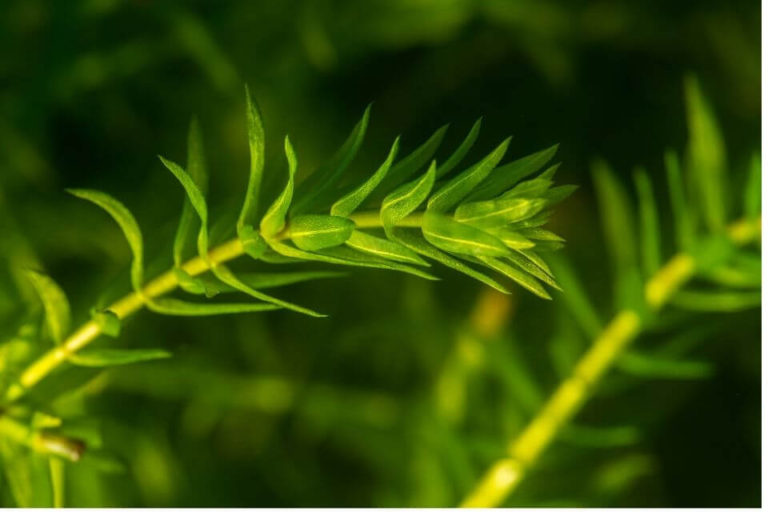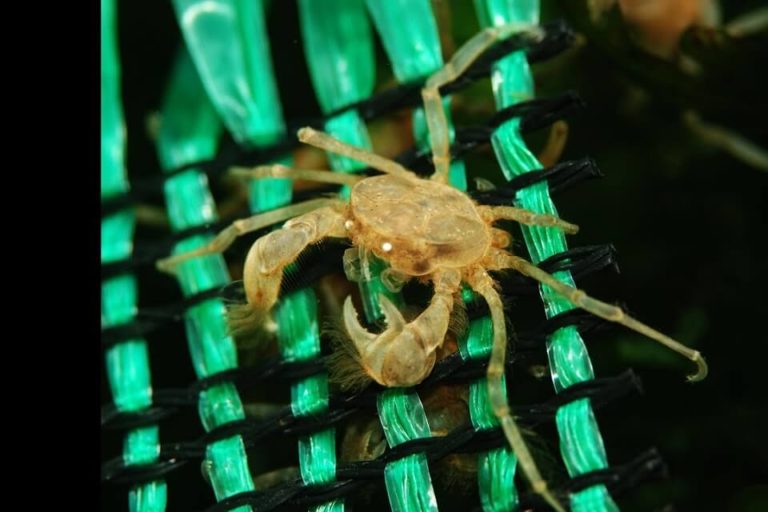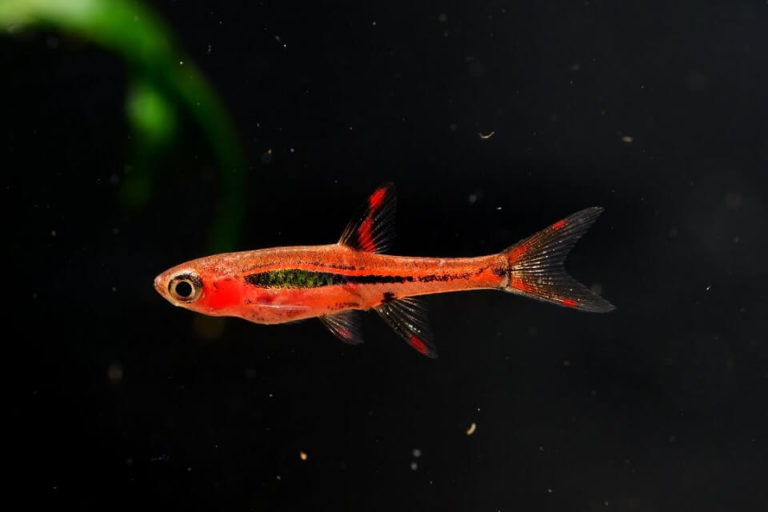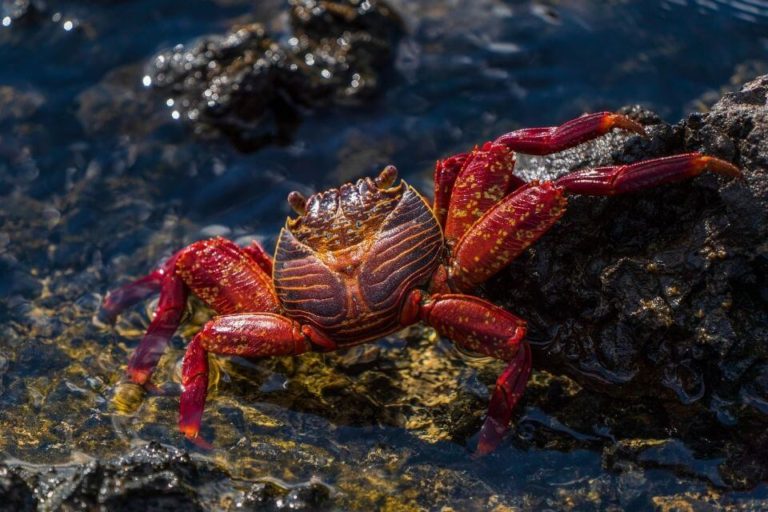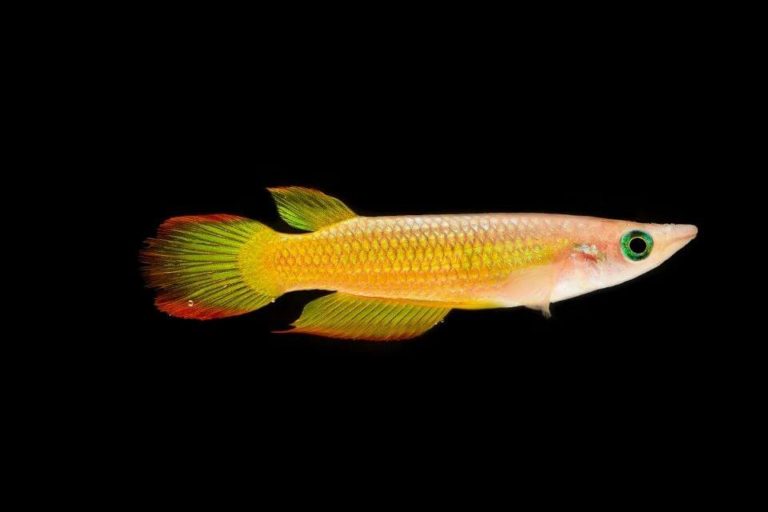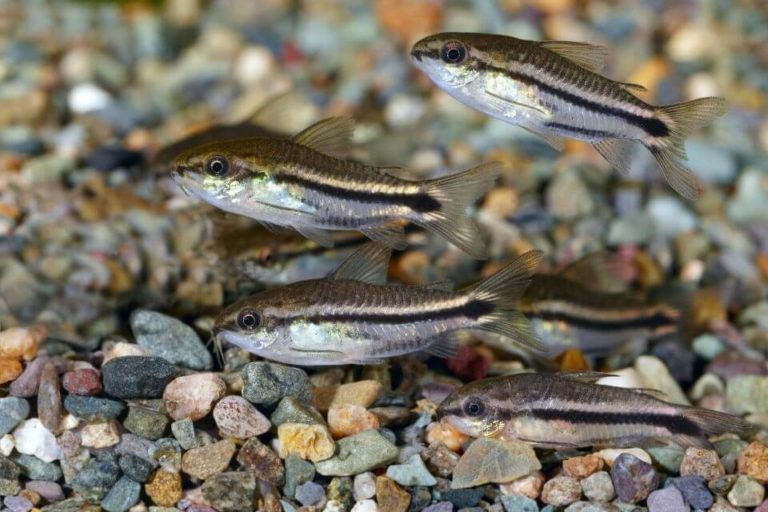Otocinclus Catfish Care: Food, Tank Size, Tank Mates, Breeding
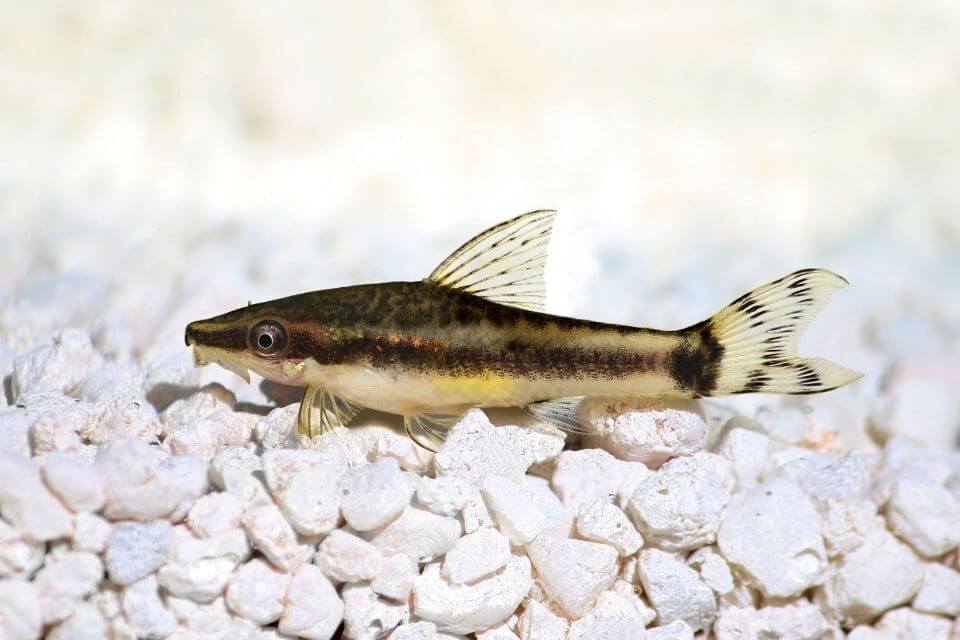
Otocinclus Catfish is small freshwater aquarium fish species that is a `very calm and collected fish. In terms of temperament and cleaning abilities, they’re peaceful and community fish.
Despite its willingness to clean glass, the Otocinclus Catfish is a plant-cleaning machine. You can depend on them to do a superb job of delicately cleaning your plants while your Catfish happily gobbles up any stray particles on the foliage.
These fish are also great for keeping in aquariums with smaller fish species or Freshwater Shrimps. These Catfish species are active and delicate and are best-known algae eaters that have dwarf suckermouth.
They know to grow up to 2 inches and have a lifespan of about 3 to 5 years in a captivity environment and they are Herbivore species.
If you go along with this Otocinclus Catfish care article, you will learn about the basic care need and the species profile of Otocinclus Catfish.
| Quick Facts: | |
|---|---|
| Common Names | Otocinclus Catfish, Otos, Dwarf Suckers |
| Origin | Slow-moving and warm waters in South America especially in Brazil, Venezuela, and the Northern parts of Argentina. |
| Family | Loricariidae |
| Scientific Name | Macrotocinclus affinis |
| Care Level | Easy |
| Temperament | Peaceful |
| Social | Community friendly |
| Diet | Herbivorous |
| Size (average) | Up to 2 inches |
| Lifespan | 3 - 5 years |
| Breeding | Egg layer |
| Minimum Tank Size | 10 gallons |
| Tank Setup | Freshwater, fine sand substrate, including driftwood, rock, clay pots, and caves for hiding places. Avoid bright lights. |
| Tank Temperature | 72 - 79 °F (22 – 26 °C) |
| Water Hardness | 2 - 15 dGH |
| Water pH Level | 6.5 - 7.5 |
Species Overview
Otocinclus Catfish is a smaller freshwater Catfish species from the Loricariidae family. They are many different breeds of Otocinclus species. The different species come in different shapes, colors and sizes.
They are referred to as Dwarf Suckers or” Otos.” The Otocinclus are mainly found in Northern Argentina and Venezuela. Most of the aquarium fish are added to the tank because of their appearance.
But Otos are added due to their algae clearing ability, which may help maintain the fish tank’s ecosystem.
There are about 19 distinct species of this genus that have been identified. The color of an animal can help identify it as belonging to a certain species. However, the following species of Otocinclus Catfish are frequently seen in aquariums;
Dark brown stripes running down the sides of this Catfish’s body help identify it as Otocinclus vestitus. The stripes cover the entire animal, from head to tail. ‘Dwarf Oto,’ or Otocinclus Macros Plus are other names for this species.
Brown bodies with dark patches that cross the tail line and the uncommon end separate them from other species. With its eardrum-like structure, this species stands out from the crowd.
The Zebra Otos (Otocinclus cocama) is easily distinguished from the rest of the catfish species by its distinctive coloration. Blotches in the form of black and white stripes cover much of Otocinclus cocama’s body.
Otocinclus Catfish Size
They are very small in size. Otocinclus Catfish size can grow up to 2 inches long when fully mature. Their size makes then to be very active fish, and they can dart from one end of the tank to the other.
Otocinclus Catfish Lifespan
The lifespan of the Oto Catfish depends on the condition they are living in. In a captivity environment with the best and clean water conditions, the lifespan is 3 to 5 years. In a wild setting, Oto Catfish can live up to seven(7) years.
Behavior & Temperament
In order to stay out of harm’s way, the Otocinclus Catfish hangs out at the bottom of the tank, far from the other fish. According to the research, the Otocinclus Catfish is a highly calm and collected fish.
Their diminutive size makes them easy prey for the tank’s larger species. Because of this, you have to be more concerned about these Otos than other fish species in the tank.
As a result, they are exceptional runners and swimmers, making them extremely elusive. Because they are algae eaters or tank cleaners, they spend most of their time at the bottom of the aquarium.
They’ll go on to other parts of the tank once they’ve cleansed that one of the algae. These tiny critters can also attach themselves to the tank’s side, which is where algae grow.
When they attach themselves to the tank’s side, you can clearly see their distinctive marks. When it comes to feeding and congregating, Otocinclus Fish follow the same patterns as other species of fish.
Otocinclus Fish is very sensitive to temperature and nitrates levels. There is a need to keep regular water testing and keep them under control.
Appearance and Colors
There are many species with different appearances. Their body shape is simple cylindrical, and it narrows toward the head, and it has a caudal fin.

The head has a strong mouth that is used to extract the algae from the hard surfaces. There are different colors of the Otocinclus that allow them to camouflage.
The Zebra Oto has a more vibrant appearance that is darker in color, and they have a more camouflage look than the common Otocinclus.
Otocinclus Catfish Care
The care of the Otocinclus Catfish is very easy but keeping them can be a bit tricky. Because they need very clean water at all times to be in a good health.
There is a very high probability of Oto dying after putting them in a tank. This can be caused by contamination in the water and water quality issues. Otocinclus can appear lively and healthy and also die within a few minutes.
There is a need to ensure the aquarium is healthy for the Otocinclus to make them happy. Otocinclus is pretty hardy and also fragile at times because of the water quality issues.
If you follow these Otocinclus care requirements then you should be good to go.
– Otocinclus Catfish Tank Size
Otocinclus Catfish are small, and they are not great swimmers. The fish like to swim at the bottom. This makes the Otocinclus Catfish tank size of 10 gallons to be suitable for at least 4 to 6 Otocinclus Fish.
The Otocinclus should be kept in groups and increase the number of gallons as you increase the number of the catfish.
– Otocinclus Catfish Tank Setup
The water condition of the tank matter a lot in the survival of the Otocinclus fish. The low stock density water and pristine water depend on the source. These Catfish species need a mature filter capable of cycling at least four times a day.
You must include some hard surfaces on the tank bottom that help algae grow, which is the primary food source. Tank Substrate does not matter much if you have rocks and driftwood placed in the bottom of the tank.
Placing enough aquarium plants would be appropriate that help maintain the tank ecosystem and the growth of algae. However, they do not prefer bright lighting, so you are required to control your aquarium’s lighting.
We would recommend having some Floating Aquarium Plants that might help reduce the light that comes to the tank bottom.
– Water Conditions and Parameters
Otocinclus Fish prefer a stable pH that is neutral and slightly acidic and the water temperature should be tropical levels.
- Water temperature: 72 – 79 °F (20 – 26 °C)
- Acidity levels: 6.5 – 7.5 pH
- Water hardness: 0 – 15 dGH
– Suitable Aquarium Plants
Many plants are suitable for aquariums, including Pothos, Vining philodendron, and Spider Plants. The plant makes the aquarium attractive, and they help to keep the water quality and aquarium balanced.
The type of plants may include Rosette plans and stem plants which are flowering. We also have the plant bulbs and tubers, and floating plants.
There are many aquarium plant options that go with Otocinclus fish such as:
– Possible Diseases and Prevention
White spot disease is the most common disease in freshwater fish. Otocinclus is a freshwater catfish and is highly affected by the diseases.
There aren’t many diseases that affect Otocinclus Catfish. However, they can get fungal infections (not a surprise for most freshwater fish in an aquarium). The cleanliness of the aquarium and the quality of the aquarium’s food are both critical.
You’ll know your fish isn’t doing well if you see signs like decreased activity, sores, or a lack of hunger. If you happen to have ill fish, confine them as soon as possible to keep the sickness from spreading to the rest of the group.
Care management is one of the best ways of preventing Catfish from infection. Use of good quality water and ensure there is uniform rationing of fresh food. Additionally, one should ensure that there is proper protection of the fish from physical injury.
Otocinclus Catfish Food and Feeding
Otocinclus fish love feeding on algae that grow in the tank bottom. They are very peaceful creatures with a great appetite The Otocinclus are also known as tank cleaners or algae eaters.
They feed on the soft algae on the hard surfaces and plants leaves of the tank. Otocinclus fish also love feeding on fresh vegetables such as Zucchini.
When there are no algae for them to feed, there is a need to provide them with a substitute such as canned green beans and Repashy green gel food.
Otocinclus Catfish Gender Differences
It can be challenging to tell the gender of Otocinclus Catfish because of their identical color patterns, and they are almost the same size. As a result, they are the most challenging fish to breed.
In addition, mature females are a little larger and more comprehensive than the males upon reaching reproductive age.
One can tell their differences by looking at their sex organs, which are shaped differently, and also their size and color differences. Female Octocinclus Fish are often more vibrant and larger than males.
Otocinclus Catfish Breeding
The Otocinclus Fish breeding is not an easy task in captivity. They have particular requirements for a successful breeding process. For example, the temperature of the water, pH levels, water hardness, and aquarium lighting are the most critical factors to consider.
The catfish require warm water for successful breeding. The bleeding is realized when the male starts chasing the females in the aquarium. The female lays the eggs on the surface of the water, and the males head up to fertilize them.
The incubation period of the eggs takes a very few days, and you realize the increase of the creature in the tank.
Captive breeding of the Otocinclus Catfish is difficult due to the fish’s unique requirements. Your chances will be influenced by environmental factors like water temperature and even the type of illumination.
Because the water should be kept at a warmer temperature for breeding (rather than at a cooler temperature), the condition of the water should be your least concern.
When the male fish start chasing the females around the tank, it’s time to start thinking about breeding. Otocinclus Catfish females lay eggs in tiny clusters on the tank’s surface, where males go to fertilize them.
The Otocinclus Catfish has a short incubation period. After that, you’ll have a swarm of fry populating your aquarium, increasing its overall size. Algae and bacteria are the primary sources of sustenance for newborns as well.
The fry requires very little attention and will soon be eating the same things as the adults.
Otocinclus Catfish Tank Mates
An aquarium may look so empty with only Otocinclus Fish. Otocinclus is a very peaceful creature, and it goes along with other species quickly. However, Otocinclus fish is tiny, and they can fall prey easily to other fish.
Therefore one should not include aggressive fish species in the same tank. The best tankmates are Tetra, Barbs, Mollies varieties, and other algae eaters such as Shrimps and Snails.
Otocinclus catfish alone can leave an aquarium looking sparse and bare. As a result, it is better to keep them as secondary fish in larger aquariums. Just make sure that your aquarium is big enough to accommodate your fish.
Other Otocinclus Catfish Tankmates Include:
- Chili Rasbora
- Cherry Barbs
- Zebra Danio
- Cory Catfish
- Dwarf Gourami
- Rummy Nose Tetra
- Silver Tip Tetra
- Lemon Tetra
- Crystal Red Shrimp
- Ramshorn Snail
Origin and Distribution
Otocinclus Catfish are mostly found in South America in the live streams of rivers and tributaries that have slow-moving and warm waters. They are mainly found in the rivers of North Argentina, Venezuela, and Brazil.
They are also found in the east of the Andes. Originating in the shallow waters of South America, Otocinclus may be found all over the region, including in the likes of Venezuela and Paraguay as well as in the likes Argentina and Colombia.
Because of their algae-eating ability, they became more popular in the aquarium industry and are commercially bred and distributed worldwide for aquarium-keeping purposes.
Otocinclus Catfish are available in most of the local pet stores for sale. And also, you might find them from local breeders or online. Make sure you choose a healthy specimen at the time you buy them.
FAQs
How Many Otocinclus Catfish Should Be Kept Together?
It is recommendable to keep four(4) to six(6) Otocinclus fish together. They just need to be in a tank that is big enough to sustain their nutritional needs.
It would be best not to house any large or aggressive fish species with Otos in the same tank because they are small and can easily prey on other fish.
Can Ottos Go With Bettas?
Ottos certainly does not go well with Bettas. It is essential to study the behaviors of both of them and know what type of tank suits them. Octocinclus fish don’t like strong currents.
So one of the problems in keeping ottos and bettas together is the difference in water currents. Octocinlus will be comfortable in constant water flow. On the other hand, bettas are gentle.
Decoration of the tank can bring harmony to both octas and bettas. Also, it would be best if you have a bigger tank to ensure there is a slow down of current at one end to favor the Betta fish.
If you build a good and conducive environment for both of them, it might work, but we do not recommend keeping Betta fish and Otos together.
Is Otos Nocturnal?
Nocturnal is when they are more active at night than during the day. During the day, you will find them being lazy, and mostly they will be attached to the wall. But they go crazy when the lights are turned off.
This means that they are nocturnal. During the day, they might hide under the rocks. They also move a bit. Since they are nocturnal most of the time, they will feed when the lights are turned off.
They make a lot of movement when the lights are turned off.
Are Otos Hardy Fish?
The Otocinclus fish are hardy only when they have gotten the right condition for survival. When captured from the wild, they fail to eat during transportation, and they may die. The Oto is fragile to the water temperature and conditions.
How Big Do Otos Get?
Otocinclus fish can grow as big as 2 inches when they are fully mature.
Does Otos Eat Hair Algae?
Otocinclus fish are crazy algae eaters that clean hard surfaces such as glass and rocks. However, they do eat hair algae and almost any kind of algae that grows in the tank.
Where Can I Buy an Otocinclus Catfish?
Otocinclus fish are very variable since they can be used as tank cleaners. Aquarium advice is one of the places that is known for stocking the Otos. Amazon Otocinclus are also popular in the sale of catfish.
Take Away
Otocinclus Fish is not only a pet; they are also tank cleaners. Compared to other Catfish, the Otocinclus Fish dwell at the bottom of the tank and feed on the algae.
Otocinclus Catfish are peaceful, and they easily get along with other creatures in the tanks. The most advantageous thing about the Otocinclus Fish is that they help to keep the tank clean.
Keeping an Otocinclus Catfish around can be a lifesaver. They’re smaller Catfish than most others, and they tend to dwell up near the bottom of the aquarium.
To say nothing of the fact that they play an important function in keeping the aquarium tidy. With the natural development of algae in the tank, they can spare you the effort of feeding them regularly.



